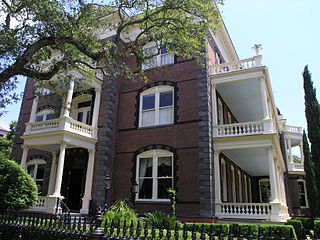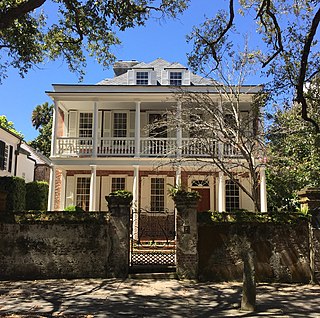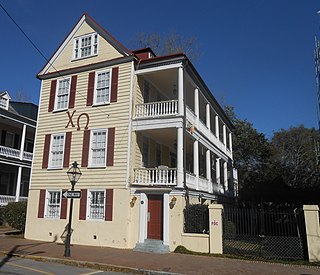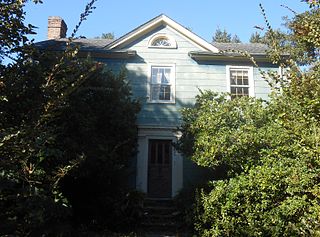Related Research Articles

Mount Pleasant is a large suburban town in Charleston County, South Carolina, United States. In the Low Country, it is the fourth largest municipality and largest town in South Carolina, and for several years was one of the state's fastest-growing areas, doubling in population between 1990 and 2000. The population was 67,843 at the 2010 census. The estimated population in 2019 was 91,684.
Riverland Terrace is a historic neighborhood in Charleston, South Carolina. It was first developed starting in 1925. It is one of James Island, South Carolina's oldest neighborhoods. The Terrace is located 10 minutes west of downtown Charleston along Wappoo Creek and the inland waterway. The neighborhood boasts a public boat landing, Charleston Municipal Golf Course, a playground, five restaurants and numerous antique shops.

Historic Charleston Foundation (HCF) was founded in 1947 to preserve and protect the integrity of architectural, historical and cultural heritage of Charleston, South Carolina, United States. The Foundation undertakes advocacy, participation in community planning, educational and volunteer programs, the preservation of historic places, research, and technical and financial assistance programs for the preservation of historic properties. Winslow Hastie has been the President & CEO of Historic Charleston Foundation since 2018.

The Richard Brenan House is an early 19th-century house at 207 Calhoun St., Charleston, South Carolina. The house was built for Richard Brenan, a merchant, in 1817 and originally included the adjacent land to the west. The house is a three-story Charleston single house with quoins and fine cornice. The house was a two-story piazza on the west side.

The Rev. Robert Smith House is a pre-Revolutionary house at 6 Glebe St., Charleston, South Carolina which is used as the official residence for the president of the College of Charleston. The present use is an odd twist of history; Rev. Robert Smith, whose name has been given to the house, was the first Episcopal bishop of South Carolina and was also himself the first president of the College of Charleston.

The Williams Mansion is a Victorian house at 16 Meeting St., Charleston, South Carolina. The mansion is open for public tours.

John Schnierle (1808–1861) was the thirty-fourth mayor of Charleston, South Carolina, serving from 1842 to 1846. He was sworn into another term as mayor of Charleston on September 6, 1843. While mayor, he lived at 31 Pitt Street. He died on April 14, 1861, and is buried at Magnolia Cemetery. In September 1851, he defeated T. Leger Hutchinson by a vote of 1,334 to 1,282.

The Robert Gibbes House in Charleston, South Carolina, was built in the Adamesque style at least by the time Robert Gibbes, Jr. was occupying it in 1819, perhaps earlier.

The Elias Vanderhorst House at 28 Chapel Street, Charleston, South Carolina, is a four-story mansion house which was built around 1835 as a home for members of the prominent Vanderhorst family of plantation owners.

The Col. John A.S. Ashe House is a historic home in Charleston, South Carolina along Charleston's Battery. Col. John A.S. Ashe, Jr. received the property upon which 26 South Battery is built upon his father's death in 1828 along with $10,000 for the construction of a house. Col. John A.S. Ashe, Jr.'s father had built the nearby Col. John Ashe House at 32 South Battery in the 1780s.

The Rebecca Screven House in Charleston, South Carolina is Charleston single house built sometime before 1828 at 35 Legare Street.

The Thomas Elfe house is a property located in the French Quarter at 54 Queen Street in Charleston, South Carolina. It was at one time owned by the well known colonial period furniture craftsman Thomas Elfe, whence its name. It is a colonial Georgian style house and a perfectly scaled miniature of a Charleston single house. The eighteenth century house has been completely restored. It is now referred to as the Thomas Elfe Workshop.

The John Ashe House is an 18th-century house at 32 South Battery, Charleston, South Carolina. The house's date of construction is unknown, but it was built sometime around 1782 and renovated in the 1930s. In August 2015, it replaced the James Simmons House as the most expensive house sold in Charleston when it fetched about $7.72 million.

The George Eveleigh House is a pre-Revolutionary house in Charleston, South Carolina. The house was built about 1743 for trader George Eveleigh. Eventually, Eveleigh returned to England and sold his house to John Bull in 1759. John Bull or one of his heirs subsequently built the house at 34 Meeting Street on the rear of the property; the parcel had originally run from Church Street through the block to Meeting Street on the west. The house retains much of its original cypress woodwork although many of the fireplace mantels were replaced in the Adam period.
Cabbage Row is a set of pre-Revolutionary buildings at 89 and 91 Church Street in Charleston, South Carolina. The buildings are most notable for having been the inspiration for "Catfish Row" in the DuBose Heyward novel Porgy and later the opera Porgy and Bess by Gershwin. DuBose Heyward had lived nearby on Church Street.

The John Fullerton House is a historic building on Legare Street in Charleston, South Carolina. The house was designed and built by Scottish master builder John Fullerton some time after he bought the land on December 31, 1772, and before he resold it at a much higher cost in 1777. Among the notable features of the house are the highly decorative window casings on the first and second floor; the console brackets and hoods reflect a high style that can be found on other notable houses of the same period in Charleston. The house is built of cypress.

The John Scott House at 38 Coming Street is one of the two oldest buildings on the Charleston, South Carolina campus of the College of Charleston.

The Daniel Elliott Huger House was the last home of a Royal governor in South Carolina.

The George Mathews House is an 18th-century house at 37 Church Street, Charleston, South Carolina. George Mathews had purchased the lot in 1743; by 1768 when the executors of his estate sold the property, the sales price strongly suggest that Mathews had the house built during his ownership. The floor plan of the house is an asymmetrical variation of a Charleston double house that is similar to the nearby George Eveleigh House. The entrance to the house was moved from its Church Street facade to the southern facade when the piazzas were added. A separate kitchen house exists in the rear.

Wagener Terrace in Charleston, South Carolina is a large neighborhood made property that had been owned by Louis Dunnemann and Capt. F.W. Wagener.
References
Coordinates: 32°46′56″N79°56′24″W / 32.782281°N 79.939959°W